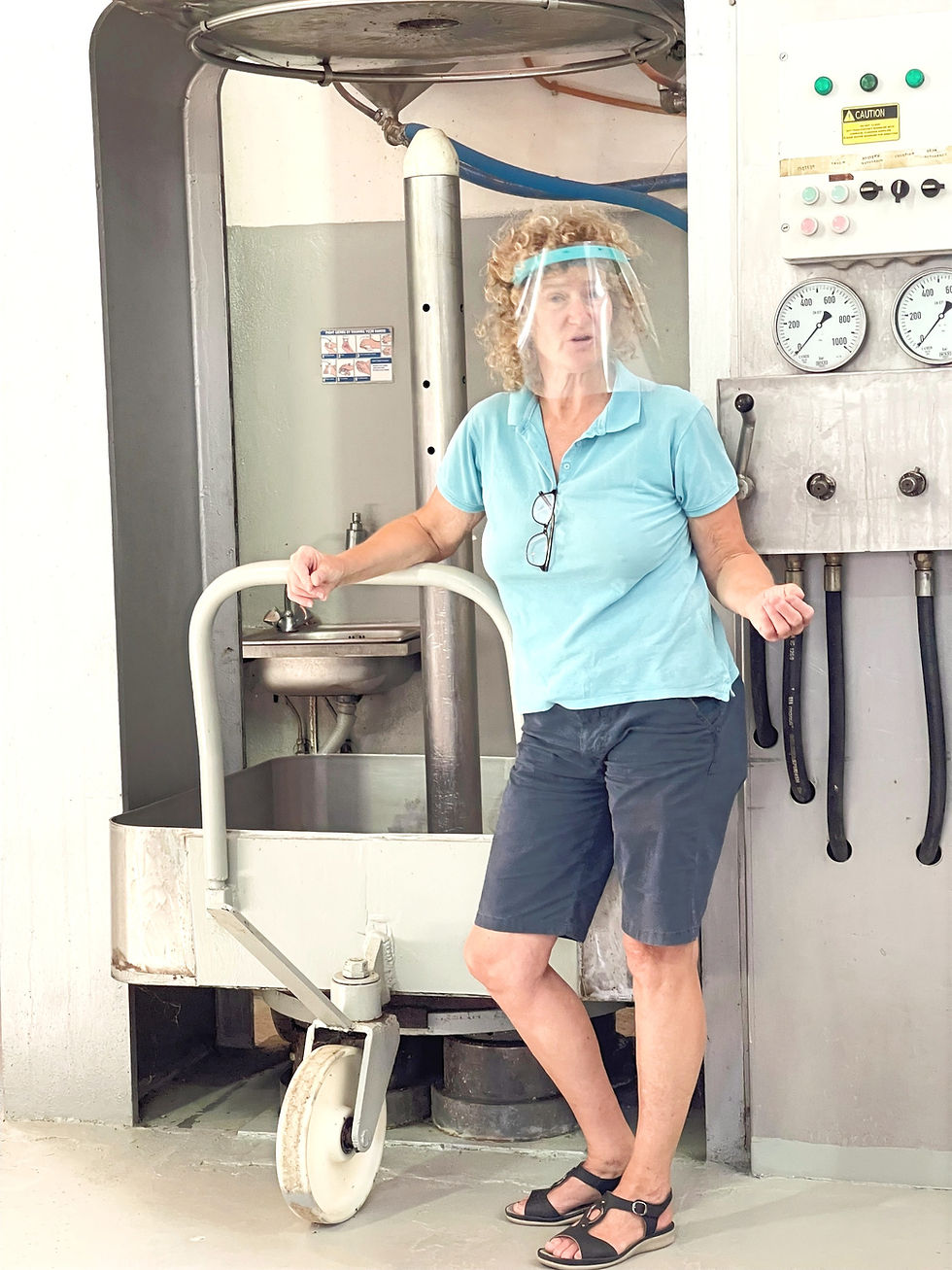Wine and Olive Oil Tasting in Crete, Greece
- Tina Walsh

- Aug 20, 2021
- 7 min read
Updated: Apr 27, 2025

Capt k and I spent two weeks exploring Crete. We fell in love with the history, the lifestyle and the wine! Once you move away from the coastal areas of Crete, the terrain changes dramatically. You are greeted by rolling hills and acres of silvery olive orchards and miles of vibrant green vineyards. The interior of Crete is the bread basket, feeding the population of Crete. Historically Crete has been very self sufficient. The earliest inhabitants of Crete traded their agricultural products for bronze and other metals allowing the Cretans to improve their farming methods.
Being a self proclaimed foodie, I am fascinated by the history of food and wine, farming methods, and unique food preparations. Even before we left home, I booked our Wine and Olive Oil Tasting Tour with Chania Wine Tours, so I could explore my passions on Crete. Chania Wine Tours is owned and operated by a husband and wife team, Vasili is a vineyard owner and winemaker. Anna Maria is a Certified Sommelier and wine writer.
They have greatly expanded their tour offering in the past year. The tour described in this post is the Wine Adventure Tour. It gives you a full day to taste, explore and understand how olive oil and wine are the cornerstones of Cretan Cuisine. Honestly as a foodie, sipping wine, tasting olive oil, and learning about the history and importance of agriculture on Crete with someone else doing the driving, I could not ask for a better day!
First Stop Cave of St. John

Our first stop was the Cave of St. John the Hermit, one of the hundreds of saints in the Greek Orthodox religion. St. John the Hermit founded one of the first monasteries on Crete, west of Chania. In his waning years, he retreated to this hillside cave.

The cave has a consecrated chapel within it's rocky walls. Services are held here on October 7th, his Saints Day, to celebrate his life. Locals often come here to pray for those who are sick or for special intentions.

In the back of the cave is a small alcove, the entrance is partially blocked by large boulders. During the years when Crete was ruled by the Turks and then the Egyptians, the Greek language and the Greek Orthodox religion was secretly taught to young children in secret caves throughout Crete. During those times in Crete, it was illegal to use the Greek language or practice the Greek Orthodox faith.

From the grounds of the Cave, the view of the fertile plateau where olive groves and vineyards thrive is spectacular. This view illustrates the importance of agriculture on Crete. Crete is responsible for 20% of Greece's wine production and 30% of Greece's olive oil production. Greece is the third largest producer of olive oil world wide, behind Spain and Italy.
Visiting the Biolea Olive Oil Factory on Crete

Our next stop was Biolea, an organic, stone-milled, cold-pressed olive oil production facility. The Astrikas Estate olive groves have been owned by the Dimitriadis Family for 5 generations. In 1994, they opened the Biolea facility to process and bottle olive oil from their groves and sell the oil under the Biolea label.The mid 18th century building pictured above houses their production, bottling, and tasting facilities.

The view from the porch is stunning, with their olive groves in the foreground and the Mediterranean Sea in the distance.

The tour of the production and bottling facility was both entertaining and enlightening. Our guide walked us through the entire process from picking to crushing to bottling and labeling.

It all starts here, where the olives are washed and leaves, debris and stems are separated.

The olives are ground to a pulp by these 4000 pound stones.

The pulp is then pressed between these filtering sheets to extract the oil, with careful attention to temperature. Extra Virgin Olive Oil comes from the initial pressing of the pulp. No chemicals are used in the extraction and the oil must contain less than 1% oleic acid. Temperatures are kept low to protect the essential nutrients and minerals. Lesser quality olive oils use hot water and/or chemicals to extract the oil. This type of processing destroys the essential nutrients and minerals in the oil.

The oil is bottled in dark green bottles to protect the oil from sunlight.
Biolea bottles three types of olive oil, traditional, lemon peel infused and orange peel infused. We had the opportunity to try all three, in their beautiful tasting room. Of course, we purchased a bottle of their high quality olive oil to take home.
Wine Tasting at Anoskeli Winery
Our next stop was the small rural village of Anoskeli and the family owned winery of the same name. This area is blanketed in olive groves, wine vineyards and orchards of orange and lemon trees. The Anoskeli winery is owned by the local Mamidakia family. In 1983 they purchased the town's old olive mill and reconstructed it for private use. As their olive oil business flourished they began to experiment with Cretan Wines. In 2004, they built a beautiful tasting room and patio for both their olive oils and their wines.
I have always been a fan of Greek white wines. They are light, crisp and easy to drink in the warm Mediterranean climate. Through participating in a formal tasting, I am beginning to appreciate the subtle differences in even the lightest of white wine. Thanks to our knowledgable but definitely not pretentious guide, I was able to taste the difference between an easy drinking aperitif white wine and one that was better suited for drinking with food. Of course with wine, there is no wrong answer and everyone's personal preference is valid. The fun is in the tasting and the conversation about each person likes and dislikes.

One of the interesting things about Greek wine and especially Cretan wine is how it is evolving in nontraditional ways. The Romeiko grape is an indigenous varietal that is grown on Crete. Traditionally, it was produced an unappealing local wine that is brownish in color. Today's Cretan wine makers are experimenting with this varietal. We had the opportunity to taste a dry red wine, made from the Romeiko grape that was aged in french oak barrels for 3 years. The flavor was delicious and quite unlike the "brown" wine traditional produced from this grape. We also tasted a lovely white wine produced from Romeiko grapes. During production the juice is quickly separated from the skins, seeds and solids, creating a white wine.
A Stop in the Vineyards on Crete
The next stop was a vineyard, to visit the grapes in their natural state. An interesting fact about the Romeiko grape is that on any bunch there will be red, white and pink grapes. This traditionally creates a lighter color, lower tannin wine, that is not as desirable. However, it adds to the grapes versatility. When you add innovative Cretan winemakers, you get some very interesting wines.
World's Oldest Olive Tree
Before heading to the next winery, we stopped to visit the World's Oldest Olive Tree. It is confirmed to be at least 2000 years old, it could be as old as 3000 to 4000 years old. Olives grow on fresh growth branch exclusively. Each year after harvest the branches are cut back to improve the harvest for the following year. The branches are cut away from the center of the tree so that the new growth resembles an umbrella. To harvest, the branches are hit with sticks to get the olives to release from the tree. The umbrella shape allows to this process to be easier, yielding more olives.
Wine Tasting and Lunch at Manousakis Winery
Our last stop was the Manousakis Winery for a tasing and lunch. The Manousakis family epitomizes the innovation that is happening in Cretan wine. In 1993 after careful study of climate and soil, Ted Manousakis planted Rhone varietal vines on the hills arounds his family's ancestral home just southeast of Chania. In 1997, the first Nostos wines were created from those vines. In 2010, they also planted Vidiano, an indigenous Cretan white varietal. On their beautiful terrace, we were able to enjoy the delicious wines from this creative vintner.

The Manousakis Winery is now under the care of Ted Manousakis' daughter Alexandra. Alexandra is a talented artist and you see you art throughout the facility including on the labels of the wine.
The lunch of Baked Lamb with Orzo and the scenery were divine. As you sit on the terrace enjoying the wine, food and views, you gain a perspective into Greek life. The importance of and pride in locally grown food and wine shared with friends and family takes you to the heart of Greek people. The warmth of the climate and the people embrace you.

CaptK and I do not always choose a tour. We have explored many a destination without a tour guide. I do find, if you are trying to see a lot in a specific place and do not have the luxury of time or if you want in depth information about a place, tours are the best way to go. If trip planning is not something you enjoy, tours do all the research and planning for you. I especially like them if wine tasting is involved, because someone else does the driving.
Are you ready to book your trip to Crete?
Check out booking.com.
We found some delightful budget friendly places to stay through them.
For notifications on new posts and access to my Dining Guides and Packing Lists, sign up for my resource page with the link below.
Looking for Travel Gear or Travel Friendly Apparel
Check out my Amazon Store and my LiketoKnowit
Looking for more information on visiting Greece,
check out these other Blog posts.












































Comments